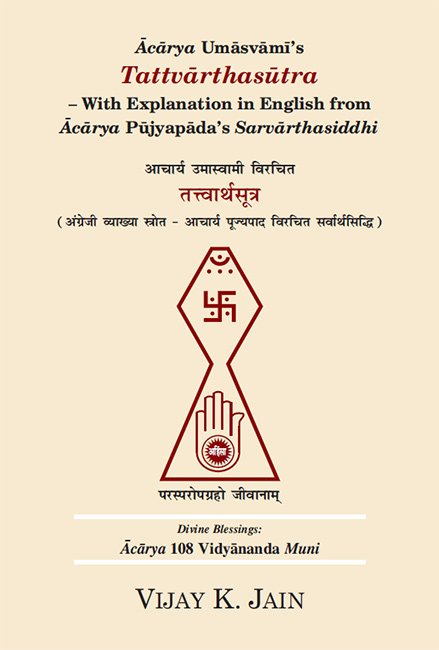Tattvartha Sutra (with commentary)
by Vijay K. Jain | 2018 | 130,587 words | ISBN-10: 8193272625 | ISBN-13: 9788193272626
This page describes wrong knowledge is whimsical which is verse 1.32 of the English translation of the Tattvartha Sutra which represents the essentials of Jainism and Jain dharma and deals with the basics on Karma, Cosmology, Ethics, Celestial beings and Liberation. The Tattvarthasutra is authorative among both Digambara and Shvetambara. This is verse 32 of the chapter Right Faith and Knowledge and includes an extensive commentary.
Verse 1.32 - Wrong knowledge is whimsical
Sanskrit text, Unicode transliteration and English translation of Tattvartha sūtra 1.32:
सदसतोरविशेषाद्यदृच्छोपलब्धेरुन्मत्तवत् ॥ १.३२ ॥
sadasatoraviśeṣādyadṛcchopalabdherunmattavat || 1.32 ||
Owing to lack of discernment between the real (sat–that exists) and the unreal (asat–that does not exist), wrong knowledge is whimsical as that of the lunatic. (32)
Hindi Anvayarth:
अन्वयार्थ: [यदृच्छोपलब्धेः] अपनी इच्छा से चाहे जैसा ग्रहण करने के कारण [सत् असतोः] विद्यमान और अविद्यमान पदार्थों का [अविशेषात्] भेदरूप ज्ञान (यथार्थ विवेक) न होने से [उन्मत्तवत्] पागल के ज्ञान की भाँति मिथ्यादृष्टि का ज्ञान विपरीत अर्थात् मिथ्याज्ञान ही होता है।
Anvayartha: [yadricchopalabdheh] apani iccha se cahe jaisa grahana karane ke karana [sat asatoh] vidyamana aura avidyamana padarthom ka [avisheshat] bhedarupa jnana (yathartha viveka) na hone se [unmattavat] pagala ke jnana ki bhamti mithyadrishti ka jnana viparita arthat mithyajnana hi hota hai |
Explanation in English from Ācārya Pūjyapāda’s Sarvārthasiddhi:
‘Sat’ is that which exists; ‘asat’ is that which does not exist. Without proper discernment, knowledge becomes erroneous. Sometimes, owing to the operation of wrong belief (mithyādarśana), when colour, form, etc., are present, these are apprehended as not present; when not present, these are apprehended as present. Also, at certain times, what exists is apprehended as existing, and what does not exist is apprehended as non-existing. For instance, the person whose mind is deranged due to disturbed bile indiscriminately considers the mother as the wife and the wife as the mother. At certain times, he may also consider, according to his whims, the mother as the mother and the wife as the wife. Even the latter is not true knowledge as it is only accidental and not based on discrimination. Similarly, error arises in case of sensory knowledge, etc., while ascertaining shape, colour, etc., of objects. It is as follows. Owing to the operation of wrong belief (mithyādarśana) three kinds of error arise: error of cause–kāraṇaviparyāsa, error of difference or non-difference–bhedābheda-viparyāsa, and error of nature–svarūpaviparyāsa, while apprehending colour, etc.
Error of cause–kāraṇaviparyāsa: Some say that the cause of colour, etc., is one, non-material and permanent. Others consider that the atoms which constitute earth, water, fire and air are of different classes, possessing four qualities, three qualities, two qualities and one quality, respectively. The atoms of one class produce things belonging to the same class. Some others say that earth, water, fire and air are four elements, characterized by the qualities of colour, odour, taste and touch. The collection of these constitutes only one type of atom called aṣṭaka (one whole, having eight parts). Still others say that different classes of atoms, such as earth, water, fire and air, characterized by qualities of hardness, fluidity, heat and movement, respectively, produce the objects in the world.
Error of difference or non-difference–bhedābhedaviparyāsa: This error entails considering the cause (kāraṇa) and effect (kārya) as either absolutely different or absolutely identical.
Error of nature–svarūpaviparyāsa: In this error, the person believes that colour, etc., are without particulars, or colour, etc., do not exist, or it is vijñāna (see footnote, p. 25) that takes the form of colour, etc., and there is no other object which is the substratum of colour, etc.
This way, owing to the rise of wrong belief (mithyādarśana), people give credence to figments of imagination which go against the known sources of knowledge and inference. Therefore, these are wrong sensory knowledge–kumati jñāna, wrong scriptural knowledge–kuśruta jñāna, and erroneous clairvoyance–vibhaṅga jñāna. But right belief (samyagdarśana) promotes conviction in substances ascertained as these truly are. Therefore, with right belief, these become sensory knowledge–matijñāna, scriptural knowledge–śrutājñāna, and clairvoyance–avadhijñāna.
